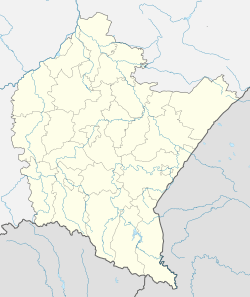Przeworsk
Przeworsk [ˈpʂɛvɔrsk], (Ukrainian: Переворськ, romanized: Perevors'k, Yiddish: פּרשעוואָרסק, romanized: Prshevorsk) is a town in south-eastern Poland with 15,675 inhabitants, as of 2 June 2009.[1] Since 1999 it has been in the Subcarpathian Voivodeship, and is the capital of Przeworsk County. The ancient Przeworsk culture was named after the town.
Przeworsk | |
|---|---|
Market Town | |
 Town Hall | |
 Flag  Coat of arms | |
 Przeworsk  Przeworsk | |
| Coordinates: 50°4′N 22°30′E | |
| Country | |
| Voivodeship | |
| County | Przeworsk County |
| Gmina | Przeworsk (urban gmina) |
| Government | |
| • Mayor | Leszek Kisiel |
| Area | |
| • Total | 21.98 km2 (8.49 sq mi) |
| Elevation | 200 m (700 ft) |
| Population (2006) | |
| • Total | 15,747 |
| • Density | 720/km2 (1,900/sq mi) |
| Time zone | UTC+1 (CET) |
| • Summer (DST) | UTC+2 (CEST) |
| Postal code | 37–200 |
| Car plates | RPZ |
| Website | http://www.przeworsk.um.gov.pl |
Przeworsk was a settlement since the 10th century, though evidence of human settlement in the general area is even older. It is first mentioned in historical records from the 13th century, and was granted its town charter in 1394. From 1772 the town was part of the Habsburg Monarchy where it remained until 1918 when an independent Poland returned. Przeworsk is located on European route E40. It also is an important railway junction, with trains going in three directions – east (towards Przemyśl), west (towards Rzeszów) and north (towards Stalowa Wola).
Przeworsk has some 60 historic buildings, including two fortified Gothic abbeys, a town hall, the Lubomirski Palace in classical style, a baroque monastery, and an open-air museum (skansen). The town covers an area of 22 square kilometres (8.5 square miles).
History
Name variations
In 13th century Ruthenian documents, Przeworsk was spelt Pereworesk. In the 14th and 15th centuries, its name was subject to variation. It was called Preworsko, Przeworsko, Przeworszko, Przeworscho, Przeiworsko, Przyworsko and Prziborsko. Since the 15th century, the name Przeworsko was most often used.
Recorded history
In the early Middle Ages, a defensive gord existed there. It was first mentioned in documents from 1280, when, after the Battle of Gozlice (23 February 1280) between Lesser Polish and Ruthenian-Tatar forces, Duke Leszek II the Black raided the Kingdom of Galicia–Volhynia, then part of the Kingdom of Ruthenia, capturing and setting alight the city of "Perevoresk" (Переворескъ):
Въ лѣт̑ 6789 (1281) Иде Льстько на Лва и взѧ оу него городъ Переворескъ и исъсѣче и люди в нем̑ вси ѿ мала и до велика и город̑ зажьже и поиде назадъ во своӕси"[2]
In the year 6789, (European date 1281) Leszek attacked Leo I of Galicia and took his city of Perevoresk and killed all in it, sparing neither young or old and having burnt the town to the ground he left.
After the Galicia–Volhynia Wars in mid-14th century, the territory of the Kingdom of Galicia–Volhynia, Kingdom of Ruthenia, was annexed by the Kingdom of Poland and transformed into the Ruthenian Voivodeship. Soon Polish settlers came to the deserted border areas, and in November 1387, King Władysław II Jagiełło ceded Przeworsk to the Voivode of Sandomierz, Jan of Tarnow, Leliwa coat of arms. Przeworsk grew fast, and on 25 February 1393, Jagiełło granted it a town charter.
Until the 18th century, Przeworsk was the private fiefdom of several Polish noble families, as it passed through Tarnowski, Ostrogski and Lubomirski ownership. Since 1470, it was the seat of the Land court for the western territory of Przemysl Land in the Ruthenian Voivodeship. Przeworsk became the second largest town in the area after Przemyśl, prospering in the period known as, the Polish Golden Age. It was situated on a round hill, 212 metres (696 feet) above sea level. Its center was protected by a rampart with a moat. The town hall was built in the 15th century.
Since Crimean Tatars often raided the southeastern corner of Poland, in 1510 the construction of ramparts was started. The defences of Przeworsk consisted of three main elements: a fortified Bernardine monastery in the east, a fortified Order of the Holy Sepulchre monastery in the west, and the town with its three gates in the middle. These fortifications turned out to be inadequate, as both in 1612 and 1624, Przeworsk was captured by the Tatars. Later, the town was captured by the Cossacks (1672, 1677), Swedes (1702) and Russians during the Great Northern War. On 22/23 March 1656, Charles X Gustav of Sweden spent one night here, during his failed raid on south-central Poland. Przeworsk suffered in several successive fires (1712, 1717, 1739, 1740, 1759). All these events contributed to the town's steep decline.
In 1772 (see Partitions of Poland), Przeworsk was annexed by the Habsburg Empire, remaining in Austrian Galicia until November 1918. In the late 18th century, the Austrian authorities pulled down the obsolete late-medieval ramparts and gates. The town remained in decline until the late 19th century, when it became a railway junction, and a center of sugar production, with the Przeworsk Sugar Refinery (1895). In 1859, Przeworsk was connected by rail with Kraków. In 1902 it had a new railroad to Rozwadow, and in 1904, a narrow gauge line to Dynow was completed. The population began to grow, new housing was built, together with a monument dedicated to Władysław Jagiełło (1910), but World War One brought destruction to the town.
During the Second Polish Republic, Przeworsk was part of Lwow Voivodeship. In 1929, it became of a county seat and in 1930, several buildings burned down in a fire.
Jewish community
The Pshevorsk Hasidic dynasty, which originated in Przeworsk, is now mainly located in Antwerp, Belgium.
Przeworsk was captured by the Wehrmacht on 9 September 1939. The German occupation lasted until 27 July 1944 and the Jewish community was decimated in German extermination camps.
People associated with Przeworsk

- Piotr Aigner – architect of the Lubomirski Palace
- Fryderyk Bauman – architect, sculptor and designer of the Lubomirski Palace interiors
- Andrzej Ćwierz – Member of the Sejm
- Antoni Lubomirski – founder with his wife, Zofia Lubomirska, of the Sisters of St. Vincent de Paul convent and church
- Zofia Lubomirska – founder of the vast textile and silk factories
- Izabela Maria Lubomirska – princess
- Henryk Ludwik Lubomirski – prince
- Paweł Miesiąc – Motorcycle speedway rider
- Zygmunt Mycielski – composer and musicologist
- Andrzej Sztolf – Olympic ski-jumper
- Stanisław Żuk – creator of the Skansen Museum and shepherd
Tourist attractions
- Basilica, built in the 15th century with a unique chapel – Tomb of Jesus Christ (the same as in Jerusalem)
- Church of the Bernardine Order
- Palace and park of Lubomirski family
- The only truly "vivid" open-air museum in Poland, with wooden houses from Przeworsk and the surrounding region.
- The Wąskotorówka Train (narrow gauge railway) going from Przeworsk to Dynów.
International relations
Twin towns – Sister cities
Przeworsk is twinned with:
References
- Notes
- "Population. Size and structure by territorial division" (PDF). 1995–2009 Central Statistical Office 00-925 Warsaw, Al. Niepodległości 208. 2 June 2009. Retrieved 22 June 2009. External link in
|publisher=(help) - Ruthenian chronicle after the Hypatian list, Galicia-Volhynian chronicle
